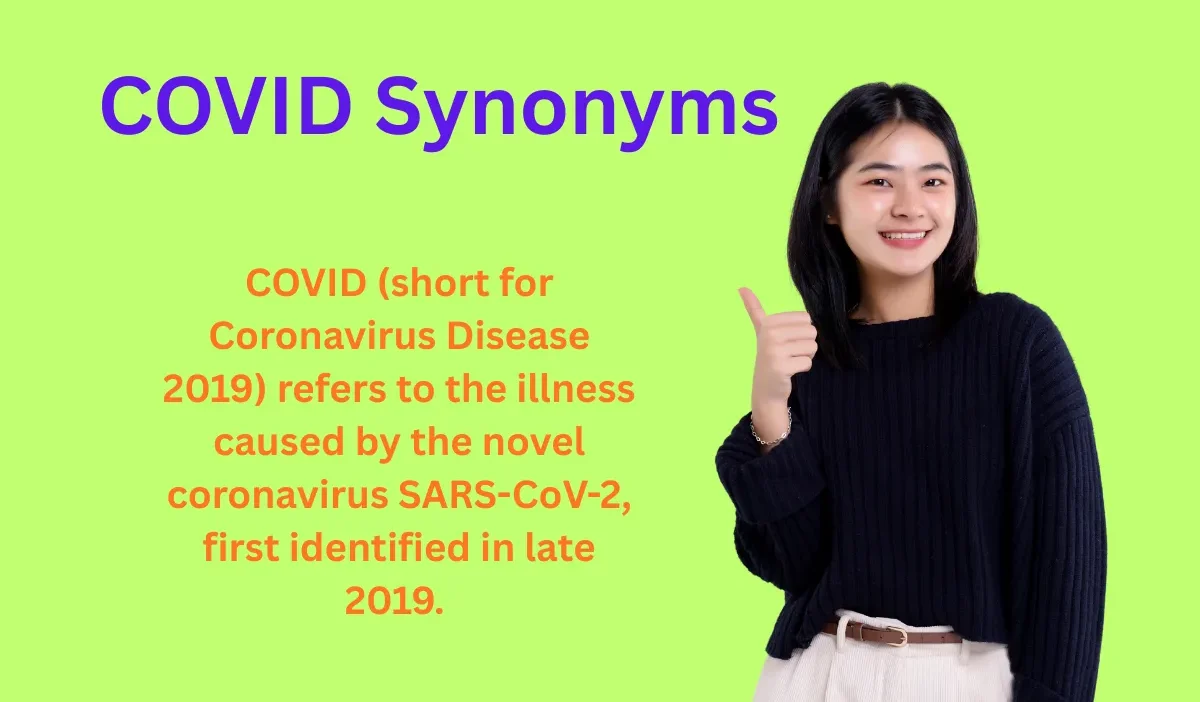COVID synonyms, such as coronavirus, SARS-CoV-2, pandemic virus, and novel coronavirus, capture different nuances of the global viral outbreak. For example, SARS-CoV-2 is the scientific term emphasizing the virus itself, while pandemic highlights the widespread nature of the outbreak. These words help writers, journalists, and communicators describe COVID-related topics with accuracy and clarity.
If you’re writing about health, science, news reporting, or historical documentation, choosing the right synonym lets you strike the perfect tone—formal, scientific, or conversational. In this guide, we’ll explore multiple ways to refer to COVID and when each term fits best.
These synonyms of COVID not only enrich your writing but also help you convey context, seriousness, and specificity. From casual conversation to scientific research, the term reflects a wide range of medical, social, and historical implications.
What Does COVID Mean?
COVID (short for Coronavirus Disease 2019) refers to the illness caused by the novel coronavirus SARS-CoV-2, first identified in late 2019. It can cause respiratory symptoms, ranging from mild cold-like signs to severe illness and complications.
The term “COVID” can describe:
- The virus itself (SARS-CoV-2)
- The disease caused by the virus
- The global pandemic and its societal impact
COVID isn’t just a disease—it represents a global health challenge with lasting effects on communities, economies, and public policy.
Synonyms & Related Words for COVID (1–30)
1. Coronavirus
Meaning: A virus of the family Coronaviridae
Example: “The coronavirus spread rapidly in 2020.”
Use when: General or scientific discussions.
2. SARS-CoV-2
Meaning: The specific virus causing COVID-19
Example: “SARS-CoV-2 has several variants.”
Use when: Scientific, medical, or formal contexts.
3. Novel Coronavirus
Meaning: Newly identified coronavirus
Example: “The novel coronavirus was first detected in Wuhan.”
Use when: Early pandemic or technical descriptions.
4. Pandemic Virus
Meaning: Virus causing widespread global infection
Example: “The pandemic virus impacted millions worldwide.”
Use when: Emphasizing scale and impact.
5. COVID-19
Meaning: Disease caused by SARS-CoV-2
Example: “COVID-19 symptoms include fever and cough.”
Use when: Medical, scientific, or news contexts.
6. Coronavirus Disease
Meaning: Formal term for COVID-19
Example: “Coronavirus disease affected daily life globally.”
Use when: Academic or professional writing.
7. Viral Infection
Meaning: Infection caused by a virus
Example: “COVID-19 is a viral infection affecting the lungs.”
Use when: Health or medical contexts.
8. Outbreak
Meaning: Sudden increase in disease cases
Example: “The outbreak began in late 2019.”
Use when: News, medical, or historical context.
9. Epidemic
Meaning: Rapid spread of disease in a region
Example: “COVID-19 was initially considered an epidemic in Wuhan.”
Use when: Regional or early-stage discussions.
10. Contagion
Meaning: Disease capable of spreading easily
Example: “Measures were taken to prevent contagion.”
Use when: Formal or medical writing.
11. Virus
Meaning: Infectious agent
Example: “The virus spreads through droplets.”
Use when: Casual or scientific reference.
12. Infectious Disease
Meaning: Disease caused by a pathogen
Example: “COVID-19 is an infectious disease requiring quarantine.”
Use when: Medical or educational contexts.
13. Respiratory Virus
Meaning: Virus affecting the respiratory system
Example: “COVID-19 is a respiratory virus.”
Use when: Scientific or descriptive tone.
14. Health Crisis
Meaning: Emergency affecting public health
Example: “COVID-19 became a global health crisis.”
Use when: Broad societal context.
15. Public Health Emergency
Meaning: Officially recognized health threat
Example: “The WHO declared COVID-19 a public health emergency.”
Use when: Formal or legal context.
16. Novel Pathogen
Meaning: Newly identified infectious agent
Example: “COVID-19 is a novel pathogen requiring study.”
Use when: Scientific or technical tone.
17. Respiratory Illness
Meaning: Disease affecting lungs and airways
Example: “Symptoms of respiratory illness include cough and fever.”
Use when: Health or general discussion.
18. Coronavirus Infection
Meaning: Infection caused by coronavirus
Example: “Coronavirus infection can range from mild to severe.”
Use when: Formal, medical writing.
19. Global Pandemic
Meaning: Worldwide epidemic
Example: “COVID-19 evolved into a global pandemic.”
Use when: Historical or news context.
20. Virus Outbreak
Meaning: Sudden emergence of viral cases
Example: “The virus outbreak led to lockdowns.”
Use when: Media or public context.
21. Health Threat
Meaning: Situation posing risk to health
Example: “COVID-19 presented a major health threat.”
Use when: General or journalistic tone.
22. Infectious Agent
Meaning: Organism causing disease
Example: “SARS-CoV-2 is an infectious agent.”
Use when: Scientific description.
23. Severe Acute Respiratory Syndrome
Meaning: Respiratory illness category, related to SARS-CoV-2
Example: “SARS-CoV-2 is part of the severe acute respiratory syndrome family.”
Use when: Medical, technical context.
24. Pandemic Illness
Meaning: Widespread disease affecting populations
Example: “COVID-19 is classified as a pandemic illness.”
Use when: Formal or educational context.
25. Epidemic Disease
Meaning: Disease spreading rapidly
Example: “Initially, COVID-19 was treated as an epidemic disease.”
Use when: Historical or descriptive tone.
26. Contagious Disease
Meaning: Easily transmitted illness
Example: “COVID-19 is a highly contagious disease.”
Use when: Medical or public guidance contexts.
27. Viral Outbreak
Meaning: Sudden increase in viral infections
Example: “The viral outbreak caused widespread concern.”
Use when: Media, news, or public health reporting.
28. Infective Agent
Meaning: Pathogen causing infection
Example: “The infective agent responsible for COVID-19 is SARS-CoV-2.”
Use when: Scientific context.
29. Novel Respiratory Virus
Meaning: Newly discovered virus affecting the lungs
Example: “COVID-19 is a novel respiratory virus.”
Use when: Scientific or medical context.
30. Zoonotic Virus
Meaning: Virus transmitted from animals to humans
Example: “SARS-CoV-2 is a zoonotic virus.”
Use when: Technical, research-focused writing.
Choosing the Right Synonym
When selecting a synonym for COVID, consider:
- Tone: Scientific (SARS-CoV-2, novel pathogen), casual (coronavirus, virus), or formal (pandemic illness, public health emergency)
- Context: News, research, public awareness, or medical writing
- Specificity: Use SARS-CoV-2 for virus, COVID-19 for disease, pandemic for scale, and zoonotic for origin
- Formality: Casual writing allows coronavirus or virus; formal writing favors scientific or official terminology
Conclusion
COVID is more than a term—it represents a global viral disease, public health crisis, and societal challenge. Its synonyms, from coronavirus to SARS-CoV-2, allow you to match tone, specificity, and context precisely. Whether discussing scientific research, public policy, or general news, each synonym highlights a different aspect of COVID.
By understanding nuance, formality, and context, you can choose the perfect word for COVID, making your writing accurate, clear, and impactful.



